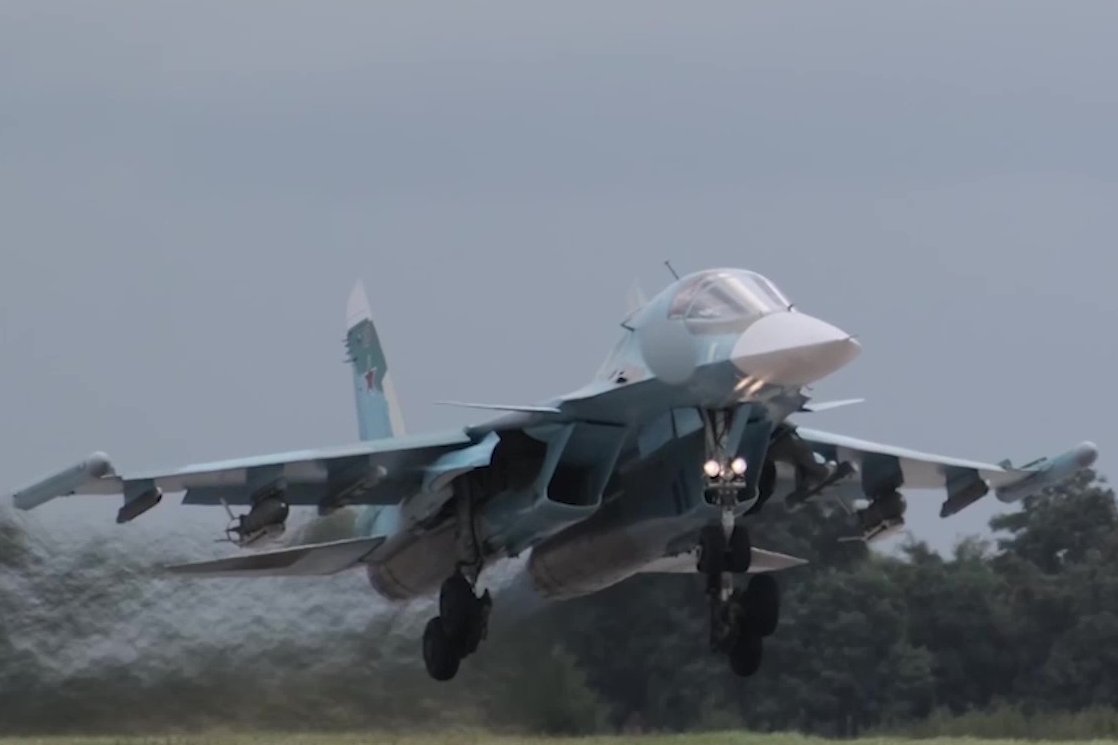Russian Telegram channel Fighterbomber, which reportedly has an affiliation with the Russian Air Force, recently stated that the software for managing the weapons system aboard the Su-34 is being updated to enable the release of UMPC bombs. With the upgrade, these smart bombs will reportedly become smarter.
Combining a UMPC bomb and the Su-34 is a force to reckon with. Conceptually, UMPC is comparable to the US Joint Direct Attack Munition (JDAM), which transforms “dumb bombs” or unguided bombs into precision-guided, all-weather munitions. For instance, the UMPC kits are mounted on FAB-250 and FAB-500 bombs, among others.
A UMPC kit is attached to a free-falling bomb to transform it into a guided bomb. The module has a control system that fires ammunition automatically at the target, folding wings and rudders. The kit essentially makes any bomb into a high-precision one and thus could be used to attack high-value targets.
Therefore, the Russian Aerospace Forces (VKS) has decided to launch a mass training program to teach fighter pilots how to use aerial bombs with UMPC (Universal Module for Planning & Correction), Russian language agency RIA Novosti reported.
The report also noted that the Su-34 bomber frequently drops bombs with 250, 500, and 1500 kilograms of UMPC caliber on Ukraine. In addition to destroying enemy air targets, the Su-34 is built to perform accurate missile and bomb strikes against ground targets in tactical and operational depth.
Russia’s Su-34 tactical bomber, which Russian aviators affectionately call the Duckling due to its flattened nose cone, has proven to be a potent armament system throughout the conflict.

“A batch of Su-34 frontline bombers was recently transferred to one of the training centers of the Russian Aerospace Forces, which will be used for mass training of pilots in the use of air bombs with UMPC that have already proven themselves in the area of the special operation in Ukraine.
“This will increase the number of pilots who can use this ammunition and increase strikes with smart air bombs in the SVO zone on Ukrainian military facilities,” an informed unnamed insider was quoted as saying by the RIA report.
As per the source, the combat efficacy of the UMPC has been established in the so-called ‘Special Military Operation Zone’ by the Russian forces. It is inexpensive and guarantees the precise attack on Ukrainian troops on the line of contact. UMPC strikes often target enemy personnel concentrations, deployment sites, fortifications, and command centers.
The UMPC made it possible for a Su-34 to conduct high-altitude patrols, maximize endurance and minimize fuel consumption, and deliver precise assaults on targets in Ukraine from a distance of up to 70 km, far beyond the reach of Ukrainian air defenses.
The short flight duration of UMPC-equipped bombs makes engaging with air defense systems very tough, making them invincible. Smart bombs enable aircraft to avoid the enemy’s air defense zone. This is dependent on the aircraft’s height and speed. To destroy the target, the plane does not have to fly very close to it and drop the required amount of bombs over it.
It required several months for the UMPC kits’ performance to stabilize so mass production could begin. However, they make the Su-34 a very potent system by allowing it to carry a heavy payload.
Su-34 aircraft armed with FAB-500M62 UMPC were seen inflicting heavy damage on Ukrainian troops soon after the Ukrainian counteroffensive was launched in June this year. Currently, Su-34s also use massive FAB-1500M54 UMPC bombs, whose first successful combat use was recorded in early September.
‼️🇷🇺💥 Russian Army Deploys FAB-1500 with UPMK for the First Time, Reports Fighterbomber
▪️ The range of bomb delivery has been significantly increased (compared to similar, lower-yield munitions) thanks to the new glider design.
▪️ With an advertised accuracy of 5 meters, the… pic.twitter.com/lRTr0qHr4P
— Zlatti71 (@djuric_zlatko) September 5, 2023
Since the UMPC bombs were first introduced into the battlefield, Russian forces have increased the accuracy of the UMPC kits and added other improvements, like the capability to set target coordinates from the cockpit before releasing the bomb, which increases the explosives’ adaptability. The new set of software upgrades, as reported by FighterBomber, is anticipated to bolster its accuracy and efficacy further.
While Russia is working on making its firepower more lethal, Ukraine has once again been left wanting in the delivery of long-range Ground Launched Small Diameter Bomb (GLSDB).
GLSDB Not Coming To Ukraine This Year!
As per the Pentagon and individuals acquainted with the schedule, Ukraine will have to bide its time until next year to receive the first significant consignment of rocket-propelled bombs that the United States has modified to launch at a range of around 100 miles (160 kilometers).
Citing a document accessed by it last October, Reuters reported when Boeing first asked the US to purchase and sell the Ground Launched Small Diameter Bomb (GLSDB) to Ukraine, the most optimistic shipping schedule was somewhere in the spring of this year. Politico revealed in February that delivery might occur later in 2023.
Ukraine requires GLSDB to supplement the few ATACMS rockets with a 100-mile range that the US has delivered. The Ukrainian military will be able to attack targets twice as far as they can currently with missiles fired by the High Mobility Artillery Rocket System (HIMARS) provided by the United States.

It can be fired from HIMARS and was anticipated to put all of Russia’s supply corridors in the east of the country and parts of Crimea within reach. Experts predicted that Russian forces would be exposed, forcing Moscow to transfer its supplies from the front lines.
According to people who know the present schedule, Boeing, the GLSDB’s prime contractor, will send the munitions to the United States in late December. It will then undergo several months of testing before being shipped to Ukraine.
A Pentagon spokesman said, “We anticipate providing this key capability in the early 2024 timeframe after successful verification,” another term for testing. The GLSDB bombs are a relatively recent modification of the GBU-39/B Small Diameter Bombs (SDBs), first promised to Ukraine in February.
Russia claimed to have intercepted and shot down the Ground-Launched Small Diameter Bomb (GLSDB) in March this year, just over a month after the US promised the weapon in its military aid to Ukraine. However, these claims have since been refuted by relevant authorities in the US and Ukraine.
- Contact the author at sakshi.tiwari9555 (at) gmail.com
- Follow EurAsian Times on Google News




